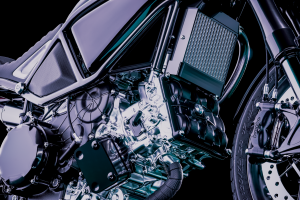Can you share your journey and how you became involved in the world of automotive visualisation?
I have quickly seen that real-time 3D visualization was going to explode with opportunities and new workflows so I set about devoting pretty much all of my time to progressing and learning each new development that came along. I freelanced for companies all over the world from Medical, Beauty and Sports goods before ending up in the Film &TV industry using real-time tech to push media through Virtual Production. After this, I joined Jaguar Land Rover.
What inspired you to specialise in automotive 3D visualisation, and what do you find most exciting about it?
I’ve been quite excited to push real-time tech into automotive. I think there are loads of areas that could really benefit from it and this industry is at such an early age of adoption for this tech that innovations can come quickly and fast. I’m excited to push the latest and greatest advancements in AI, VP and more into our pipeline and see how fast we can deliver from concept to final pixel.

As a real-time lead, what are the key responsibilities and challenges you face in your role?
A lot of the challenges come from unifying all these great developments. I see so many compartmentalized or isolated innovations/“edge cases”. The tricky part is identifying where this can benefit our pipeline and how best to put this into production. My responsibilities include training our creative teams to better use Unreal Engine and Chaos Vantage, looking to the future and seeing what’s about to change the industry or what is about to shake up a lot of workflows. It’s also my responsibility to make sure our teams have the best tools and workflows available to them as they start to leave their more traditional rendering practices behind.
Could you describe your favourite project or achievement in the automotive real-time visualization field?
I think one of my biggest achievements personally comes every day when I see our artists producing fantastic things. From art to cool new blueprints that can help raise our quality ceiling that little bit further. I’m like a kid in a toy shop with real time so seeing others feel that same sense of satisfaction and joy makes it 10x more rewarding.
How has real-time technology, including tools like Unreal Engine, transformed the way automotive design and development processes are carried out in recent years?
Traditional pipelines were often slow, bulky and prone to lacking new features and updates. realtime tech (more specifically Unreal Engine) changed that overnight. Features were coming monthly, forcing pipelines to adapt. Integration with things like mobile, VR, web and more allowed departments like CMF, Design and even Engineering the ability to get feedback in an instant. No more waiting for hours on a render or for a manager to find the time to check something over. Meetings can be held live. VR meetings can be held with clients or colleagues even in another country (which blew my mind when I first experienced it)
Could you describe the role of real-time, and how it complements traditional visualization techniques, in streamlining automotive design and design review processes?
Let’s be real (pun intended), real-time rendering quality is not on par with traditional rendering right now, as much as we want to admit it. Certain areas such as caustics, true reflections etc will always be far more accurate being rendered traditionally. Where realtime shines though is in its ability to make a massive amount of iterations in just a few minutes. Suddenly render sequences can be produced thousands of frames long right after a feedback session. Dramatically shortening review times and allowing more feedback to take place at a faster pace catching what can sometimes slip through a crack if enough time has passed between reviews. Live meetings are also a critical process. Being able to sit with a lead or a designer and in real time modify the visuals and even the underlying meshes allows for a much stronger collaborative effort between teams.

What advantages does real-time VR offer in terms of collaborative design reviews and decision-making within your team?
VR is a core process in this new evolution of the Automotive industry and it’s now exposing more traditional artists and designers to the digital tech and the quality it can bring. With the right pipeline and processes set up you can have a diverse live meeting in VR between multiple teams from CMF all the way through to marketing. All teams are able to be on the same page and communication is much more effectively shown when able to talk about something you all can see, even if it’s not “real”.
Are there specific challenges or limitations you’ve encountered when implementing real-time design workflows, and how have you addressed them?
To be able to effectively train artists to use real-time in an efficient and effective way it’s been a challenge to get people to drop their pre-conceived ways of working (traditionally). I’m frequently asked how to do xyx as Vray or Arnold can do abc and sometimes it’s frustrating telling them it’s not possible yet. I always stress that being an early adopter of tech and features means we might not have feature parity across software and just to have an open mind about figuring out another way to do it.
What impact has real-time technology had on the efficiency of the vehicle prototyping and testing phases at Jaguar Land Rover?
Our testing phases have shortened dramatically. We are able to present near finished looking work at the very first stages of a project. This allows us to really nail things like lighting/colour and more early on so that the rest of the project is streamlined and it just becomes a case of massaging the shots to get the final quality we aim to hit.
How does the use of real-time VR benefit the visualisation and assessment of vehicle interiors and exteriors during the design phase?
With Unreal Engine we can quickly set up VR logic to showcase our interiors and exteriors in different lighting environments, materials and finishes and different states of animation. We can scrub through animations of a door opening or a seat reclining and in VR, being able to see this really up close allows artists and designers the ability to see every inch of the car and scrutinise it that much more.
Can you provide insights into how real-time technology enhances the overall quality of automotive design at your organisation?
With the compliments I explained earlier, the advantage of real-time is it allows us to conduct R&D almost at the same time. This means that things that weren’t possible or feasible before such as complex procedural animations and effects can now be introduced into a project at the start and worked on. Allowing us to explore and introduce more types of elements and art and effectively raise our quality by pushing ourselves more and more each time.
What are some innovative ways you see real-time technology being applied in the automotive industry beyond design and prototyping?
The market is becoming saturated with configurators. Almost to the point they have lost their initial appeal. I’ve seen some really innovative ways these experiences have evolved to the point it doesn’t feel like a configurator and more like a really curated game or storyline.Roblox and Fortnite are massive things for brands and real-time tech has become such a core component of being able to deliver engaging and often engaging marketing opportunities for automotive companies. I think this is a massively underutilized tool that is dismissed because of its target market.
Could you share some thoughts on producing successful virtual production projects?
Pre-production. I cannot stress this enough. Plan every single thing. Plan for any eventuality you can think of. If it sounds likely it will happen, chances are it will. I’ve seen so many virtual production setups and projects implode because they haven’t planned for something and it just goes belly up. Plan and organise everything and you will be thanking yourself at the end of a project.
How do you envision the future of real-time technology in the automotive industry, and what trends do you anticipate?
I think the future is a seamless transition between real-time and traditional. We are already seeing companies like Chaos truly embracing the real-time space. So being able to effortlessly switch between a really realistic Vray scene into a real-time Vantage scene with the VR and LED wall abilities means this is going to be a very interesting few years ahead.\
Are there any emerging technologies or tools that you believe will play a significant role in advancing real-time capabilities for design and virtual production?
There are too many to name them all. AI is becoming a real hotspot for all things creative. Utilising it in a morally and efficient way can mean your conceptual phases and turnaround are only days long now instead of weeks. Now that Unreal Engine has a real competitor in Chaos Vantage I hope that competition sparks a race to the top. Omniverse is around and really powerful too. But for the purposes of this interview, I’ve only mentioned UE and CV as they are really accessible and for students still studying, the best software to break into the real-time space.
What challenges and opportunities do you see in the integration of augmented reality (AR) and real-time technology for design and production purposes?
I am a very big advocate for AR in the right places. I think the challenge is trying to find a way to meaningfully add it to a pipeline. The gap between AR and VR is getting smaller, Mobile-based AR is very powerful and now with LiDAR capability it’s easier than ever to be able to scan a room or an object and have it in real-time software in minutes. What happens then? You now have a scan of an object, it needs to be efficiently processed and needs to be able to adapt to other pipelines such as exporting and going back to traditional rendering or VR.
Can you share your thoughts on the potential environmental and sustainability benefits of real-time technology in automotive design and production?
Clients I’ve worked with have no longer been required to board a plane and fly halfway across the world just to view a presentation for an hour. We can now do that in 3D space live. We can deliver feedback sessions live. Another major one is we no longer need to hire a large crew and fly somewhere for a shoot for three or four weeks. No need to be in a remote location when we can do it on-site or at a nearby studio. Saving money AND being greener for the planet. What’s not to like?
How does Jaguar Land Rover approach the balance between traditional design processes and the integration of real-time technologies?
We are very aware of the limitations of real time and we still need to be sensible about what projects can be fully real-time or partial shots etc. This all comes down to effective planning and recognising where real-time can jump in and pick up things or deliver a rockstar project from start to finish.

What advice would you give to aspiring professionals looking to enter the field of automotive realtime?
Explore everything you can. Don’t try to be the hero that has 5/6/7 massive projects on their portfolio. I’d much rather see a blog or experiments page where I can see the real you, your interests and methods in approaching things. Keep your scope small. My philosophy to learning is rapid experiments and faster failures. By your 8th or 9th project, you will be in a much more comfortable place able to confidently showcase some great looking realtime.
Finally, could you offer your insights and predictions regarding the future of real-time technology and its impact on the automotive design and production landscape, or even the industry in general?
I think real-time will be everywhere. I mean, it already is but in a much more in-your-face way about it. My hope is that the UK government and education sectors realize that not everything needs to be HETV or VFX-based. We need a grassroots-level education plan across the country covering real-time tech.










